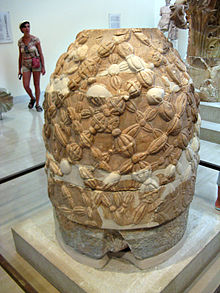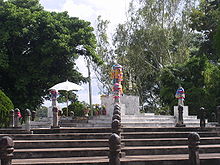- Omphalos
-
An omphalos (ομφαλος) is an ancient religious stone artifact, or baetylus. In Greek, the word omphalos means "navel" (compare the name of Queen Omphale). According to the ancient Greeks, Zeus sent out two eagles to fly across the world to meet at its center, the "navel" of the world. Omphalos stones used to denote this point were erected in several areas surrounding the Mediterranean Sea; the most famous of those was at the oracle in Delphi. The plant genus Omphalodes in the family Boraginaceae is commonly called navelwort. It is also the name of the stone given to Cronus in Zeus' place in Greek mythology.
Contents
Delphi
Most accounts locate the Omphalos in the temple adyton near the Pythia. The stone itself (which may have been a copy) has a carving of a knotted net covering its surface, and has a hollow centre, which widens towards its base (illustrated, to the right).
The Omphalos at Delphi came to be identified as the stone which Rhea wrapped in swaddling clothes, pretending it was Zeus. This was to deceive Cronus, his father, who swallowed his children so they could not grow up and depose him as he had deposed his own father, Uranus.
Omphalos stones were said to allow direct communication with the gods. Leicester Holland (1933) has suggested that the stone was hollow to channel intoxicating vapours breathed by the Oracle. Erwin Rohde wrote that the Python at Delphi was an earth spirit, who was conquered by Apollo, and buried under the Omphalos, and that it is a case of one god setting up his temple on the grave of another.
Christian destruction of the site in the fourth century at the order of Emperors Theodosius I and Arcadius makes all suggestions about its use tentative.
Jerusalem
In the Church of the Holy Sepulchre in Jerusalem there is also an omphalos. The existence of this stone is based upon the medieval cosmology which saw Jerusalem as the spiritual if not geographical center of the world (see T and O map). This tradition is likely based on an ancient Jewish tradition that saw Jerusalem as the navel of the world.[1] In the Jewish tradition, the Ark in the Temple in Jerusalem, through which God revealed himself to His people, rested on the Foundation stone marking the "navel of world". (This Jewish tradition is known to have begun in Hellenistic times, when Jews were already quite familiar with Greek culture - and thus, might be a deliberate emulation of and competition with the above tradition regarding Delphi).
Literature
In chapter 1 of James Joyce's Ulysses Buck Mulligan describes his home in a Martello tower as an omphalos:
Billy Pitt had them built, Buck Mulligan said, when the French were on the sea. But ours is the OMPHALOS.
 the Foundation Stone of the Jewish Temple, found in the Dome of the Rock mosque on the Temple Mount in Jerusalem.
the Foundation Stone of the Jewish Temple, found in the Dome of the Rock mosque on the Temple Mount in Jerusalem.
In chapter 14, Mulligan proposes:
... to set up there a national fertilising farm to be named OMPHALOS with an obelisk hewn and erected after the fashion of Egypt and to offer his dutiful yeoman services for the fecundation of any female of what grade of life soever who should there direct to him with the desire of fulfilling the functions of her natural.
The word also appears in chapter 3, amongst complex imagery of religion, creation and death:
One of her sisterhood lugged me squealing into life. Creation from nothing. What has she in the bag? A misbirth with a trailing navelcord, hushed in ruddy wool. The cords of all link back, strandentwining cable of all flesh. That is why mystic monks. Will you be as gods? Gaze in your omphalos.
There are a number of omphalos allusions elsewhere in literature, especially fantasy:
- The first of the Indiana Jones books, Indiana Jones and the Peril at Delphi, features the Omphalos as the MacGuffin. In the novel, the omphalos is described as a small smooth black cone with a knotted net covering its surface. The netting is described as being petrified rather than carved as it is on the actual omphalos at Delphi. When one holds the omphalos they can see into the near and distant future.
- In the Fafhrd and Gray Mouser story "Thieves' House" by Fritz Leiber, Omphal is the name of a set of jeweled bones. It is soon revealed to be one of the long-dead master thieves once revered as gods by the Thieves' Guild... but not before being desecrated by the latest guild master. The Thieves' not-exactly-dead gods don't take this lightly, and at midnight the guild regains a very fervent reverence for its ancestral origins.
- Omphalos is the name of a ship in The Unteleported Man (later republished as Lies, Inc.) by Philip K. Dick.
- Glastonbury Abbey is described as an omphalos by the character Mansur in Ariana Franklin's book Grave Goods.
- In the novel Dead Sky, Black Sun by Graham McNeill, set in the fantasy world of Warhammer 40,000, the Omphalos Daemonium is a daemon trapped in Chaos armour who captures the heroic Ultramarine Captain, Uriel Ventris, after he becomes caught up in a parallel universe.
See also
- Axis mundi
- Black Stone
- Cusco
- Göbekli Tepe
- Kaaba
- Lingam
- Umbilicus urbis Romae
- Wat Phra That Doi Chom Thong, site in Thailand known as "Navel or Omphalos" of the city
References
Further reading
- Burkert, Walter. Greek Religion, 1985.
- Farnell, Lewis Richard. The Cults of the Greek States, 1896.
- Goodrich, Norma Lorre. Priestesses, 1990.
- Guthrie, William Keith Chambers, The Greeks and their Gods, 1955.
- Holland, Leicester B. (1933). "The Mantic Mechanism at Delphi". American Journal of Archaeology 37 (14): 204–214.
- Hall, Manly Palmer. The Secret Teachings of All Ages, 1928. Ch. 14 cf. Greek Oracles,www, PRS
- Harrison, Jane Ellen. Themis: A Study of the Social Origins of Greek Religion, 1912. See p. 396 and after for a discussion on the Omphalos. [1][2]
- Homeric Hymn to Pythian Apollo
- Kitsikis, Dimitri. Omphalos, Paris, Pierre Jean Oswald, 1977.
- Rohde, Erwin. Psyche, 1925.
- Trubshaw, Bob (February 1993). "The Black Stone - the Omphalos of the Goddess". Mercian Mysteries (14). http://www.indigogroup.co.uk/edge/blstone.htm.
Categories:- Classical oracles
Wikimedia Foundation. 2010.



